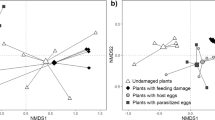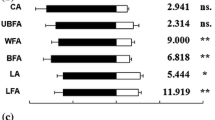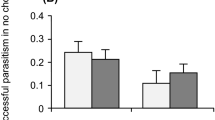Abstract
In nature, most species of Lepidoptera are attacked by parasitoids, and some species may be hosts for several parasitoid species. When hosts are parasitized by more than one female of the same species (=superparasitism) or females of different species (=multiparasitism), then intrinsic competition occurs for control of host resources. To reduce competition, some parasitoids are able to recognize the difference between parasitized and unparasitized hosts. Inter- and intra-specific host discrimination were investigated in the two sympatric species, the gregarious Cotesia kariyai (Watanabe) and solitary Meteorus pulchricornis (Wesmael), endoparasitoids of the Oriental armyworm Mythimna separata (Walker). To measure host discrimination, choice experiments were conducted in which females of both species foraged and chose between healthy host larvae and hosts initially parasitized by either C. kariyai or M. pulchricornis. An olfactory test was also performed to examine the discrimination behavior of the two parasitoids. Our results showed that, in oviposition choice tests, both braconid female wasps were able to discriminate between unparasitized hosts and from four to seven day-old hosts previously attacked by conspecific and heterospecific wasps. On the other hand, superparasitism and multiparasitism occurred even in host larvae that were parasitized two days earlier. However, once the immature parasitoids hosts are at larval stage (1st and 2nd instar), super- and multiparasitism were avoided in the two-choice test, but the latter often occurred in the multiple-choice experiment. Host discrimination abilities may have been based on plant volatile signals incurred from damaged plants and internal mechanisms from four to seven post-parasitized hosts.





Similar content being viewed by others
References
Bakker K, van Alphen JJM, van Batenburg FHD, van der Hoeven N, Nell HW, van Strien-van Liempt WTFH, Turlings TCJ (1985) The function of host discrimination and superparasitization in parasitoids. Oecologia 67:572–576
Chow A, Mackauer M (1999) Marking the package or its contents: host discrimination and acceptance in the ectoparasitoid Dendrocerus carpenteri (Hymenoptera : Megaspilidae). Can Entomol 131:495–505
Cusumano A, Peri E, Vinson B, Colazza S (2012) Interspecific extrinsic and intrinsic competitive interactions in egg parasitoids. BioControl 57:719–734
Fisher RC (1961) A study in insect multiparasitism. 2. Mechanism and control of competition for possession of host. J Exp Biol 38:605–629
Fisher RC (1963) Oxygen requirement and physiological suppression of supernumerary insect parasitoids. J Exp Biol 40:531–540
Fisher RC, Ganesali Vk (1970) Changes in composition of host haemolymph after attack by an insect parasitoid. Nature 227:191–192
Force DC (1974) Ecology of insect host-parasitoid communities. Science 184:624–632
Godfray HCJ (1994) Parasitoids: behavioral and evolutionary ecology. Princeton University Press, Princeton, USA
Greany PD, Oatman ER (1972) Analysis of host discrimination in the parasite Orgilus lepidus (Hymenoptera: Braconidae). Ann Entomol Soc Am 65:377–383
Guillot FS, Vinson SB (1972) Souces of substances which elicit a behavioral response from insect parasitoid, Campoletis perdistinctus. Nature 235:169–170
Harvey JA, Gols R, Strand MR (2009) Intrinsic competition and its effects on the survival and development of three species of endoparasitoid wasps. Entomol Exp et Applicata 130:238–248
Harvey JA, Pashalidou F, Soler R, Bezemer TM (2011) Intrinsic competition between two secondary hyperparasitoids results in temporal trophic switch. Oikos 120:226–233
Harvey JA, Poelman EH, Tanaka T (2013) Intrinsic inter- and intraspecific competition in parasitoid wasps. Ann Rev Entomol 58:333–351
Holler C, Bargen H, Vinson SB, Witt D (1994) Evidence for external use of juvenile-hormone for host marking and regulation in a parasitic wasp Dendrocerus carpenteri. J Insect Physiol 40:317–322
Janssen A (1989) Optimal host selection by Drosophila parasitoids in the field. Funct Ecol 3:469–479
Jervis MA, Ellers J, Harvey JA (2008) Resource acquisition, allocation, and utilization in parasitoid reproductive strategies. Ann Rev Entomol 53:361–385
King EG, Bell JV (1978) Interactions between a braconid, Microplitis croceipes and a fungus Nomuraea rileyi in laboratory-reared bollworm larvae. J Invertebr Pathol 31:337–340
Li L, Sun J (2011) Host suitability of a gregarious parasitoid on beetle hosts: flexibility between fitness of adult and offspring. PLoS ONE 6:e18563
Magdaraog PM, Harvey JA, Tanaka T, Gols R (2012) Intrinsic competition among solitary and gregarious endoparasitoid wasps and the phenomenon of ‘resource sharing’. Ecol Entomol 37:65–74
Marktl RC, Stauffer C, Schopf A (2002) Interspecific competition between the braconid endoparasitoids Glyptapanteles porthetriae and Glyptapanteles liparidis in Lymantria dispar larvae. Entomol Exp et Applicata 105:97–109
McBrien H, Mackauer M (1990) Heterospecific larval competition and host discrimination in two species of aphid parasitoids: Aphdius ervi and Aphidius smithi. Entomol Exp et Applicata 56:145–153
Nakamatsu Y, Gyotoku Y, Tanaka T (2001) The endoparasitoid Cotesia kariyai (Ck) regulates the growth and metabolic efficiency of Pseudaletia separata larvae by venom and Ck polydnavirus. J Insect Physiol 47:573–584
Pennacchio F, Strand MR (2006) Evolution of developmental strategies in parasitic hymenoptera. Ann Rev Entomol 51:233–258
Poelman EH, Bruinsma M, Zhu F, Weldegergis BT, Boursault AE, Jongema Y, van Loon JJA, Vet LEM, Harvey JA, Dicke M (2012) Hyperparasitoids use herbivore-induced plant volatiles to locate their parasitoid host. PLoS Biol 10:e1001435
Price PW (1970) Trail odors-recognition by insects parasitic on cocoons. Science 170:546–547
Rosenheim JA, Jepsen SJ, Matthews CE, Smith DS, Rosenheim MR (2008) Time limitation, egg limitation, the cost of oviposition, and lifetime reproduction by an insect in nature. Am Nat 172:486–496
Sait SM, Begon ME, Thompson DJ, Harvey JA (1996) Indiscriminate parasitism of baculovirus-infected Plodia interpunctella by Venturia canescens and subsequent virus transmission. Funct Ecol 10:586–591
Schroder D (1974) A study of the interactions between the internal larval parasites of Rhyacionia buoliana (Lepidoptera: Olethreutidae). Biomedical and Life Sciences, European Station, Commonwealth Institute of Biological Control, Delémont, Switzerland, pp 145–171
Sirot E (1997) Adaptive superparasitism and host-parasitoid dynamics. Bull Math Biol 59:23–41
Soler R, van der Putten WH, Harvey JA, Vet LEM, Dicke M, Bezemer TM (2012) Root herbivore effects on aboveground multitrophic interactions: patterns, processes and mechanisms. J Chem Ecol 38:756–767
Strand MR (1986) The physiological interactions of parasitoids with their hosts and their influence on reproductive strategies. In: Waage J, Greathead D (eds) Insect Parasitoids. Academic, London, UK, pp 97–136
Suzuki M, Tanaka T (2006) Virus-like particles in venom of Meteorus pulchricornis induce host hemocyte apoptosis. J Insect Physiol 52:602–613
Tillman PG, Powell JE (1992) Intraspecific host discrimination and larval competition in Microplitis croceipes, Microplitis demolitor, Cotesia kazak (Hymenoptera: Braconidae) and Hyposoter didymator (Hymenoptera: Ichneumonidae), parasitoids of Heliothis virescens (Lepidoptera: Noctuidae). Entomophaga 37:229–237
Turlings TCJ, van Batenburg FDH, van Strien-van Liempt WTFH (1985) Why is there no interspecific host discrimination in the two coexisting larval parasitoids of Drosophila species; Leptopilina heterotoma (Thomson) and Asobara tabida (Ness). Oecologia 67:352–359
van Alphen JJM, Visser ME (1990) Superparasitism as an adaptive strategy for insect parasitoids. Ann Rev Entomol 35:59–79
van Baaren J, Boivin G, Nenon JP (1994) Intraspecific and interspecific host discrimination in two closely-related egg parasitoids. Oecologia 100:325–330
Vet LEM, Dicke M (1992) Ecology and infochemical use by natural enemies in a tritrophic context. Ann Rev Entomol 37:141–172
Vinson SB (1976) Host selection by insect parasitoids. Ann Rev Entomol 21:109–133
Vinson SB, Hegazi EM (1998) A possible mechanism for the physiological suppression of conspecific eggs and larvae following superparasitism by solitary endoparasitoids. J Insect Physiol 44:703–712
Acknowledgments
We would like to thank the Applied Entomology Laboratory for the fruitful discussions and useful comments on this paper. This work was supported by the Nagoya University, Japan and Philippine Department of Agriculture-Bureau of Plant Industry.
Author information
Authors and Affiliations
Corresponding author
Additional information
Handling Editor: Stefano Colazza.
Rights and permissions
About this article
Cite this article
Magdaraog, P.M., Tanaka, T. & Harvey, J.A. Inter- and intra-specific host discrimination in gregarious and solitary endoparasitoid wasps. BioControl 58, 745–754 (2013). https://doi.org/10.1007/s10526-013-9532-0
Received:
Accepted:
Published:
Issue Date:
DOI: https://doi.org/10.1007/s10526-013-9532-0




